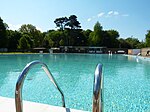Lewes District
1974 establishments in EnglandCoast to Capital Local Enterprise PartnershipEngvarB from April 2018Lewes DistrictNon-metropolitan districts of East Sussex ... and 1 more
Pages with non-numeric formatnum arguments

Lewes is a local government district in East Sussex in southern England covering an area of 113 sq mi (290 km2), with 9 miles (14.5 km) of coastline. It is named after its administrative centre, Lewes. Other towns in the district include Newhaven, Peacehaven, Seaford and Telscombe. Plumpton racecourse is within the district. There are 28 parishes in the district. The district was formed on 1 April 1974 by the Local Government Act 1972, and was a merger of the former borough of Lewes along with Newhaven and Seaford urban districts and Chailey Rural District.
Excerpt from the Wikipedia article Lewes District (License: CC BY-SA 3.0, Authors, Images).Lewes District
Castle Precincts,
Geographical coordinates (GPS) Address Nearby Places Show on map
Geographical coordinates (GPS)
| Latitude | Longitude |
|---|---|
| N 50.873888888889 ° | E 0.0088888888888889 ° |
Address
The Maltings
Castle Precincts
BN7 1YT , Southover
England, United Kingdom
Open on Google Maps











